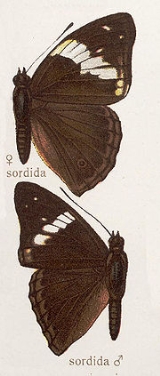
Chitoria sordida
Encyclopedia
The Sordid Emperor is a species of Nymphalid
butterfly
found in tropical Asia
.
 The males have the upperside of the fore wing
The males have the upperside of the fore wing
darkening towards the apex, the apical two-thirds much darker brown
, an oblique discal white band from interspace 6 to tornal angle formed of more or less rectangular spots; a small spot beyond in interspace 4 and two preapical spots white. Hind wing uniform, a lunular subterminal dark line inwardly bordered by a row of dark spots, and a terminal row of pale lunules. Underside pale brownish grey. Fore wing with the discal band and spots more or less as on the upperside; a black, blind, yellow-ringed ocellus, with a dark brown shade in the interspace below it; ocellus and brown shading bordered inwardly by white; a subterminal dark line, and some diffuse white marks on termen below apex and at tornus. Hind wing with an incomplete discal white band and a series of white spots beyond, ending in a well-marked, broadly yellow-ringed, blue-centred, black ocellus in interspace 2 ; lastly, a subterminal dark line as in the fore wing. Antennae brown, paler below the club ; head, thorax and abdomen brown, paler beneath.
The female
is similar; the hind wing is more rounded and the oblique discal band on the fore wing is very much broader.
The wing expanse is 68–80 mm.
Found in northeastern India and Southeast Asia
.
Nymphalidae
The Nymphalidae is a family of about 5,000 species of butterflies which are distributed throughout most of the world. These are usually medium sized to large butterflies. Most species have a reduced pair of forelegs and many hold their colourful wings flat when resting. They are also called...
butterfly
Butterfly
A butterfly is a mainly day-flying insect of the order Lepidoptera, which includes the butterflies and moths. Like other holometabolous insects, the butterfly's life cycle consists of four parts: egg, larva, pupa and adult. Most species are diurnal. Butterflies have large, often brightly coloured...
found in tropical Asia
Asia
Asia is the world's largest and most populous continent, located primarily in the eastern and northern hemispheres. It covers 8.7% of the Earth's total surface area and with approximately 3.879 billion people, it hosts 60% of the world's current human population...
.
Description
- See glossaryGlossary of Lepidopteran termsThis glossary describes the terms used in the formal descriptions of insect species, jargon used mostly by professionals or entomologist....
for terms used

Wing
A wing is an appendage with a surface that produces lift for flight or propulsion through the atmosphere, or through another gaseous or liquid fluid...
darkening towards the apex, the apical two-thirds much darker brown
Brown
Brown is a color term, denoting a range of composite colors produced by a mixture of orange, red, rose, or yellow with black or gray. The term is from Old English brún, in origin for any dusky or dark shade of color....
, an oblique discal white band from interspace 6 to tornal angle formed of more or less rectangular spots; a small spot beyond in interspace 4 and two preapical spots white. Hind wing uniform, a lunular subterminal dark line inwardly bordered by a row of dark spots, and a terminal row of pale lunules. Underside pale brownish grey. Fore wing with the discal band and spots more or less as on the upperside; a black, blind, yellow-ringed ocellus, with a dark brown shade in the interspace below it; ocellus and brown shading bordered inwardly by white; a subterminal dark line, and some diffuse white marks on termen below apex and at tornus. Hind wing with an incomplete discal white band and a series of white spots beyond, ending in a well-marked, broadly yellow-ringed, blue-centred, black ocellus in interspace 2 ; lastly, a subterminal dark line as in the fore wing. Antennae brown, paler below the club ; head, thorax and abdomen brown, paler beneath.
The female
Female
Female is the sex of an organism, or a part of an organism, which produces non-mobile ova .- Defining characteristics :The ova are defined as the larger gametes in a heterogamous reproduction system, while the smaller, usually motile gamete, the spermatozoon, is produced by the male...
is similar; the hind wing is more rounded and the oblique discal band on the fore wing is very much broader.
The wing expanse is 68–80 mm.
Found in northeastern India and Southeast Asia
Southeast Asia
Southeast Asia, South-East Asia, South East Asia or Southeastern Asia is a subregion of Asia, consisting of the countries that are geographically south of China, east of India, west of New Guinea and north of Australia. The region lies on the intersection of geological plates, with heavy seismic...
.

